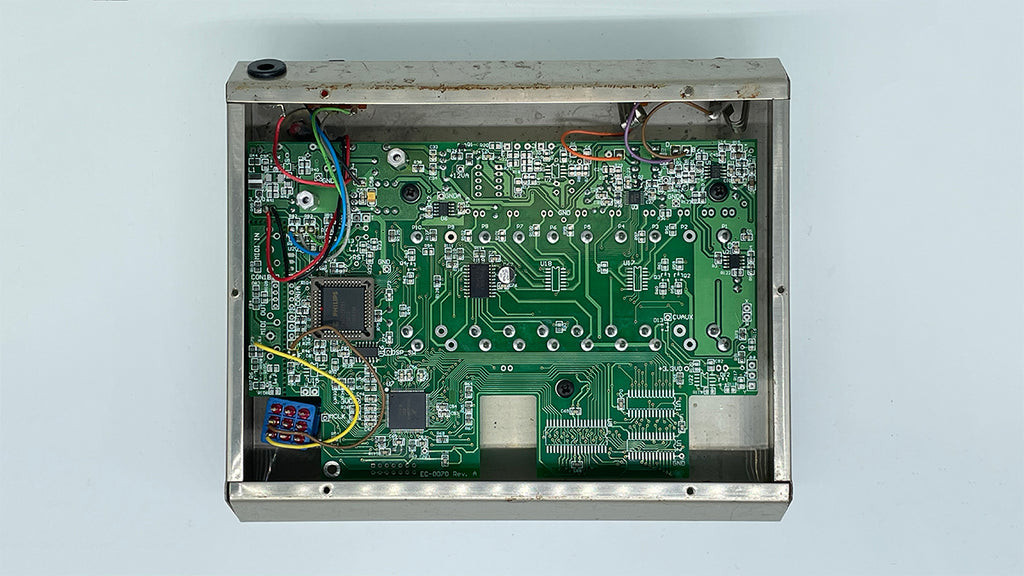Stepping away from the usual array of stompboxes, sometimes revisiting the classics is essential. Digging into the pedal closet reveals trusted companions, including the Electro-Harmonix POG. While vintage gear holds a certain allure, practicalities like power and jack placement often lead to favoring reliable workhorses. The POG, a constant on the board, exemplifies this dependability and enduring relevance in the world of guitar effects.
We currently exist in a “golden age” for guitar pedals. The market is saturated with manufacturers, competition is fierce, and Digital Signal Processing (DSP) advancements have democratized pedal creation. However, it’s easy to forget that certain now-commonplace effect categories were once in their nascent stages not too long ago.
Consider octave pedals. Historically, they were largely limited to two types: a harsh, unpredictable octave-up effect typically paired with fuzz circuits, heavily reliant on finicky variables, or a bass-like, often muddy, octave-down effect. Playing chords through either resulted in a dissonant jumble of frequencies and atonal chaos. The ability to cleanly process multiple notes simultaneously became known as “tracking.”
This limitation persisted for decades. As far back as the 1960s, units like the Conn Multi Vider combined these effect types with limited success. Early octave-up fuzzes and octave-down pedals struggled with tracking, particularly when presented with chords. Digital technology was needed to overcome the inherent limitations of analog octave effects.
 Electro-Harmonix POG Pedal
Electro-Harmonix POG Pedal
The digital revolution began in 1989 with the DigiTech Whammy (WH-1). While groundbreaking, its tracking wasn’t perfect, and pitch manipulation was confined to pre-set intervals. However, it planted the seed: guitarists craved clean, polyphonic octave effects capable of handling chords. While DigiTech iterated through five Whammy versions to perfect polyphonic tracking, Electro-Harmonix delivered a game-changer much sooner: the Polyphonic Octave Generator, or Pog Guitar Effect pedal.
Working in a music store when the POG was released, the impact was immediate. Everyone, including seasoned players and effect novices, wanted one. EHX, known for its bold approach, launched a full-featured, larger format POG initially, followed by a more compact version later. The original, large “sheet metal” enclosure POG boasted features that still rival modern pedals, possessing a unique charm and comprehensive control.
At its core, the POG guitar effect pedal offers three distinct voices: one octave below, one octave above, and two octaves above the original pitch, each with independent volume controls. Furthermore, EHX included separate sliders for detuned versions of both the one and two octave-up voices. Combining detuned and standard octave voices allowed for incredibly thick and complex textures. EHX’s “sheet metal” era pedals were uncompromising in their feature sets, giving users a vast sonic palette. The POG offered enough control to venture into sonic chaos, ensuring that musicians of all types could find inspiring and usable sounds. Pushing both two-octave sliders to their limits might not be universally practical, but it unlocks unique, extreme sonic territories.
To manage the inherent brightness from stacking multiple octave-up voices, especially with four engaged, EHX cleverly incorporated a three-mode low-pass filter. This feature tamed harsh high frequencies, allowing for smoother, more musical octave layering. Additionally, a dedicated slider allowed users to blend out the dry, unaffected guitar signal entirely, immersing themselves fully in the octave-shifted soundscape.
The POG’s unique, powerful, and functional polyphonic octave capabilities made it an instant must-have. Guitar luminaries like Jack White, John Mayer, The Edge, and Josh Homme embraced the POG guitar effect pedal, showcasing its versatility across genres. EHX subsequently expanded the POG family with the Micro POG, Nano POG, POG2, HOG, HOG2, and even incorporated polyphony into the Ring Thing, solidifying the POG’s legacy as a foundational digital octave effect.
